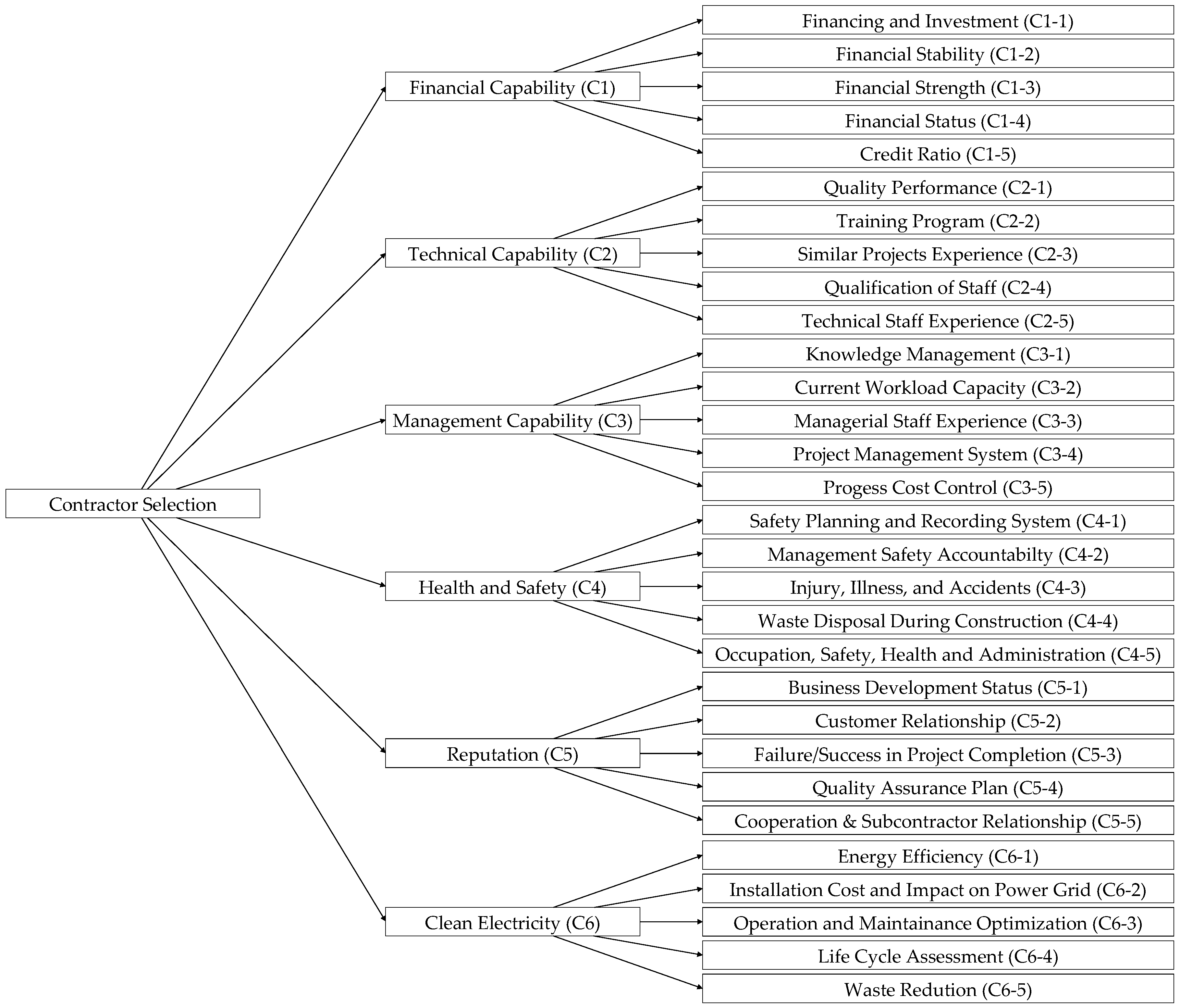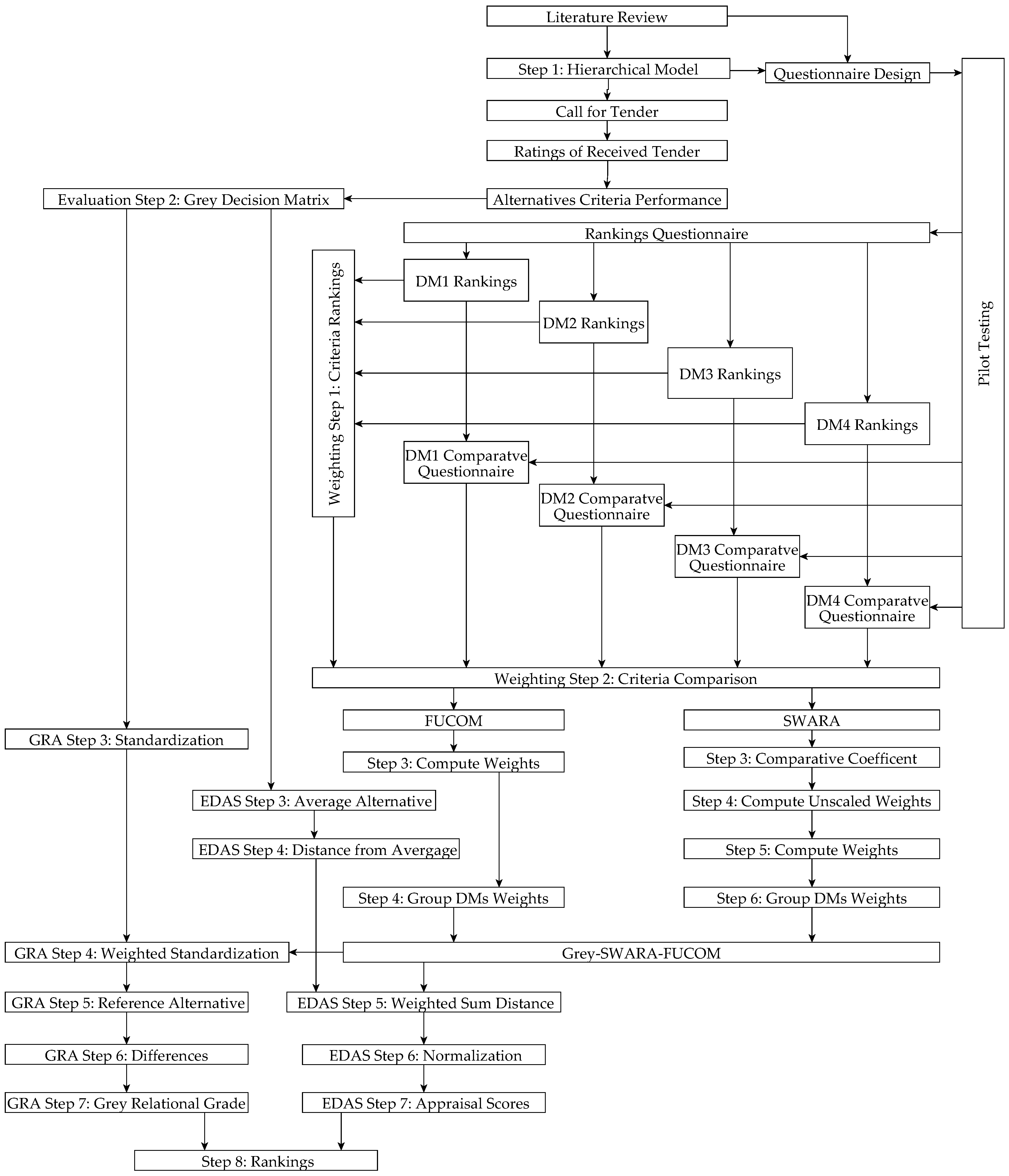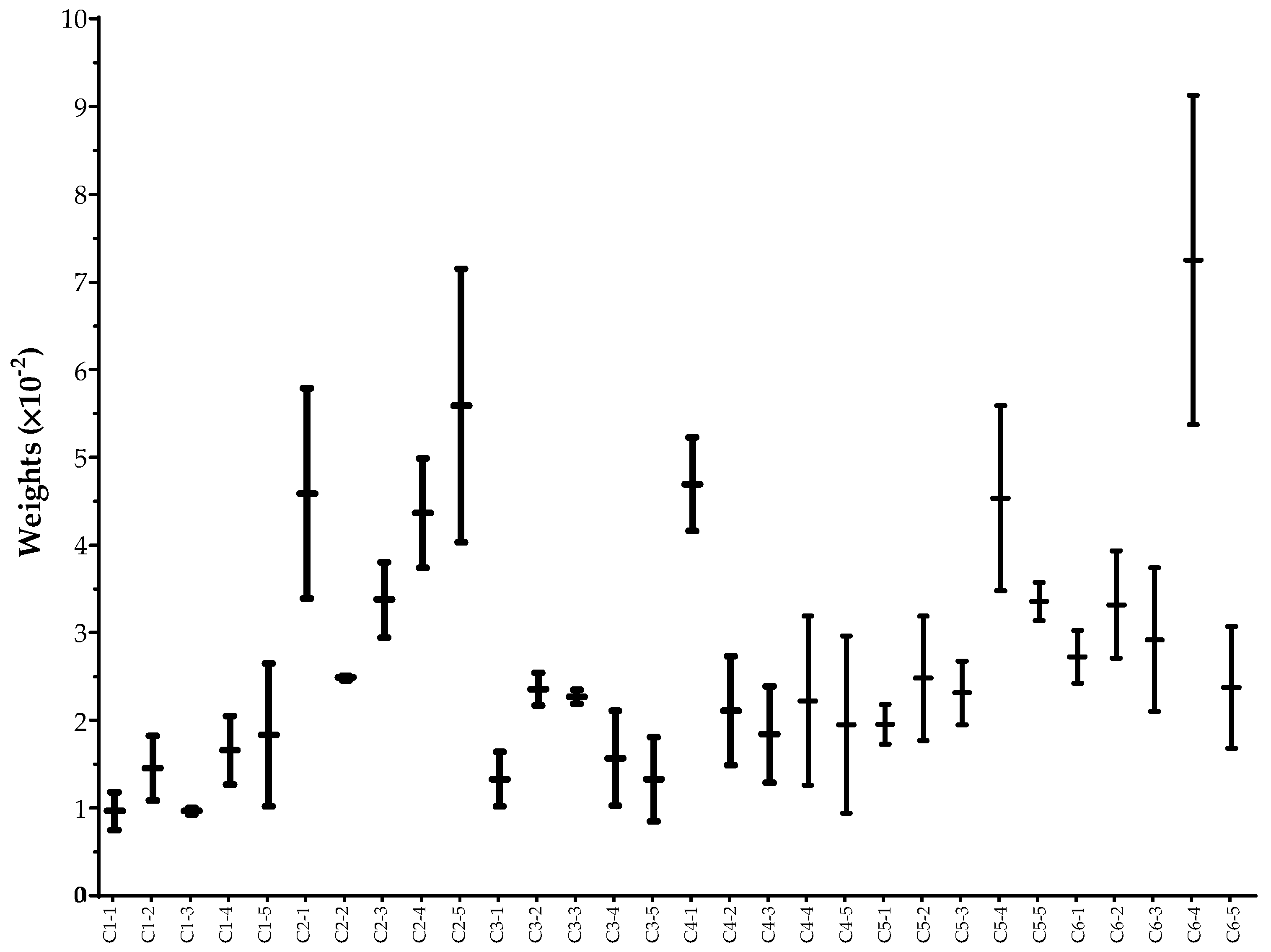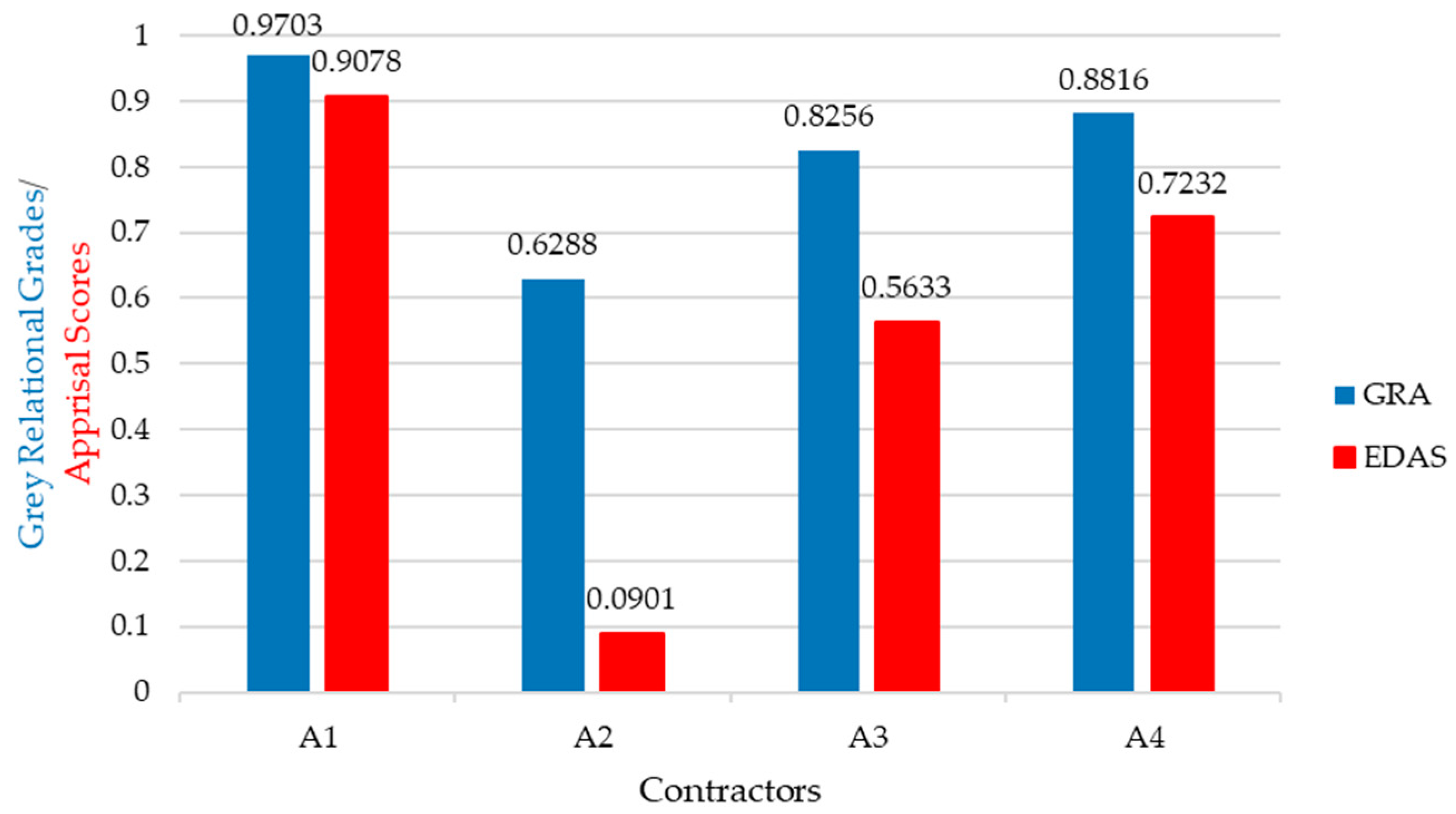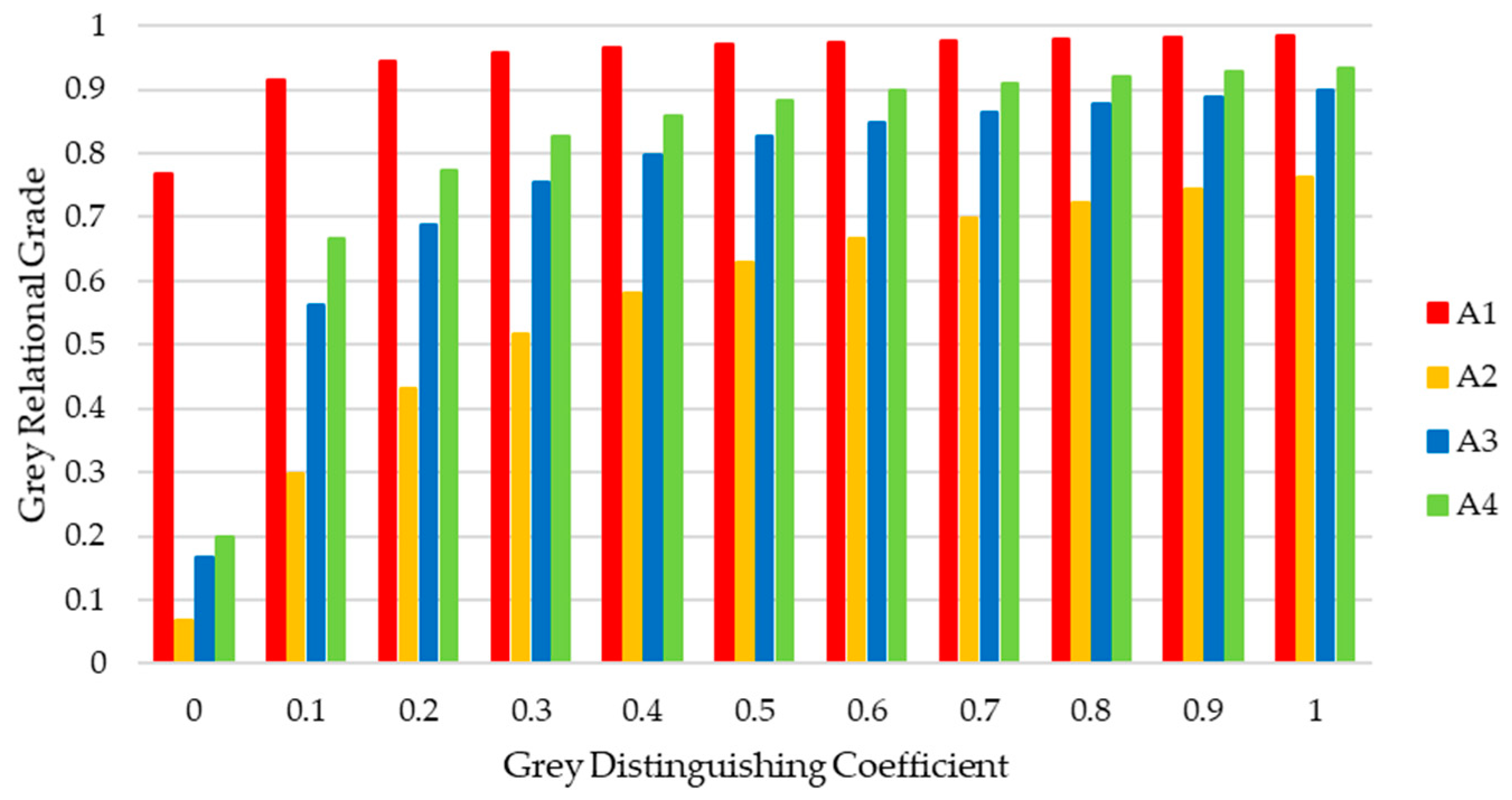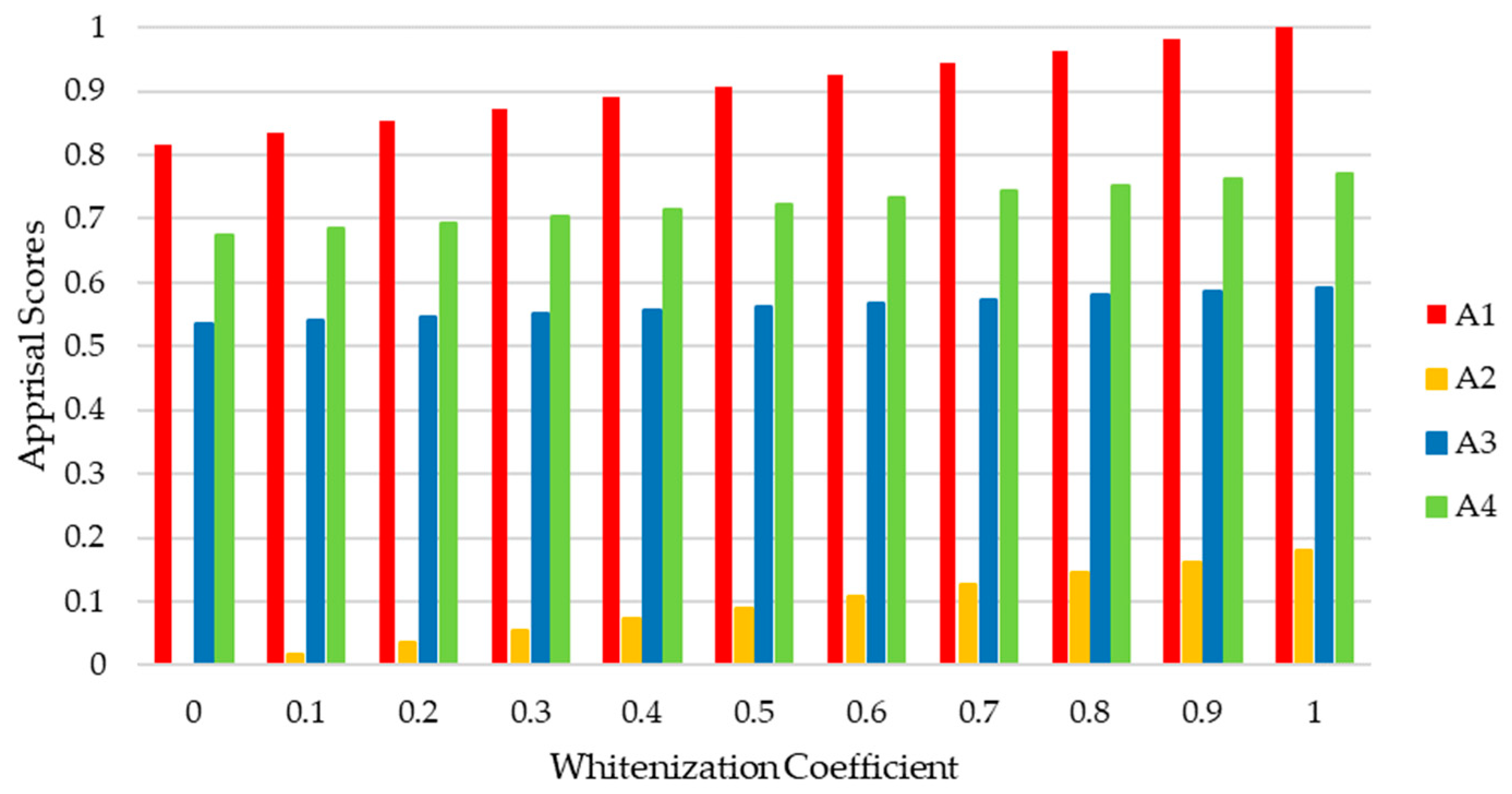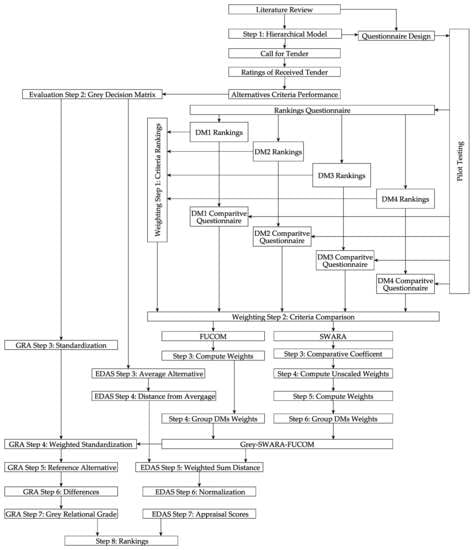Generally, MCDM weighting method can be grouped into two main classifications: subjective and objection. Subjective weights are weights obtained by points been allocated to the criteria by the DMs, and these points could be in the form of linguistic variable. An example of subjective weighting method is the analytical hierarchical process (AHP) [
9], where a worksheet is given to the DM that compares two criteria at a time. Relative scores are given to the criteria based on the scale provided. Next, the scores are aggregated by adding all the scores. Then, the results are scaled to a sum put to one, and the consistency of the weights is validated. Another example is the SMART [
10], where points are assigned from the least important criterion to the most important criterion without a limit to the points assigned to the most important criterion. Then, the weights are estimated by normalizing the total number of points. By contrast, the objective weights are primarily based on the computational methods with little or no intervention by the decision-makers. For instance, the equal weighting method [
2], which is an even distribution of the weight across all criteria. Moreover, one clear example of the objective weight is the entropy weighting method [
11]. The entropy weights are based on the extent to which the information on the system is reflected and the extent of uncertainty in the system. The SWARA and FUCOM approaches combine the advantages of subjective and objective weighting approaches.
2.1. Solar Panel Implementation
The main thread in the literature is generating the most electrical energy from the sun, and Siksnelyte et al. [
12] presented an overview of the MCDM methods in addressing sustainability problems. Among the MCDM method reported are the AHP [
13], analytic network process (ANP) [
14], fuzzy set [
15], technique for order of preference by similarity to ideal solution (TOPSIS) [
16], weighted aggregated sum product assessment (WASPAS) [
17], PROMETHEE [
18], VIKOR [
19], ELECTRE [
20], analysis and synthesis of parameters under information deficiency (ASPID) [
21] and multi-objective optimization by a ratio analysis (MULTIMOORA) [
22]. Reshma and Sreejith [
23] analyzed the maximum power point tracking controller for a PV system and reported that higher efficiency and reduced switching loss is achievable using interleaving and coupled-inductor-based topologies. The design of a power system with optimal maximum power transfer capacity has been the general focus of researchers in recent years, as indicated by Shinde and Mane [
24]. They also indicated that there is still room to reduce the fabrication cost and improve energy management as well as convergence of the rooftop solar system to maximize the power transfer capacity. Sherwani et al. [
25] showed that the energy payback time is between 1.5 and 5.7 years and greenhouse gas emission is as low as 9.4 g-CO
2/kWhe and as high as 280 g-CO
2/kWhe using solar panel energy.
The implementation of solar panels for electricity generation is a global solution for both developing and developed nations. Akhtar et al. [
26] recommended the use of solar reflectors to increase the solar energy generated in Pakistan. Akinyele et al. [
27] presented the global developmental progress in PV using the situation in Nigeria as a case study. They suggested that, when building a solar panel plant in underdeveloped countries, the technical facility, financing, and administration should be considered. Topcu [
28] proposed a decision model for the selection of a contractor in Turkey that consisted of the prequalification and choice stages. The AHP was used in estimating the weights of the evaluation criteria with the simple additive weighting method, and the primary objective was to select the contractor with the best bid based on the expert ratings using the evaluation criteria, but not selecting the contractor with the lowest bid. After 15 years, Topcu et al. [
29] revisited the previous proposal [
28], updated it and presented an evaluation hybrid approach that integrated the Monte Carlo Simulation, entropy, and Bordo count method. They concluded that renewable energy sources should be included in the generation of electricity in Turkey. Chan and Starcher [
30] evaluated the performance of wind and solar energy investments in Texas, USA by conducting a feasibility analysis that computes the payback period of the investment, net present value, internal rate of return, and profitability index.
Some researchers compared alternative energy sources and maximized the use of the power produced by an existing solar plant as a linear program. Abu-Hamdeh and Alnefaie [
31] compared a PV system to a wind turbine solar power tower system and diesel generator on a small load. The PV system was the best cost-effective energy source. Andrade et al. [
32] designed a DC–DC converter, which is more efficient in a distributed PV generation system. Bhattacharyya et al. [
33] presented a concept of combining PV solar energy with hydrogen production for efficient energy generation. The design used the electricity produced by the PV module for alkaline water electrolysis. Fan and Xu [
34] formulated a multi-objective optimization problem in maximizing energy savings and economic benefits by defining a constraint on the net present value and payback period. This was solved as a non-linear programming problem by the weighted sum method. Tu et al. [
35] presented a mixed integer linear programming (MILP) model to minimize the overall cost of electricity that consists of a PV power source, wind turbine, diesel generator, and energy storage system. Maghami et al. [
36] recommended daily cleaning when the dirt intensity was high and weekly cleaning for the dry season of the solar panel, to reduce the power loss resulting from soil on the panel.
The use of MCDM methods in deciding the most appropriate solar energy solution is presented in the literature. Wang et al. [
37] used the hybrid of fuzzy ANP (FANP) and TOPSIS to select the best location among seven other places for the construction of a nuclear power plant in Vietnam. The FANP is used for weighting the criteria based on expert consultation, and the TOPSIS method is used to evaluate the locations. Lui et al. [
38] evaluated low-carbon planning as an MCDM problem by proposing a hybrid of DANP and VIKOR method. Nie et al. [
39] combined an interval neutrosophic set and the WASPAS to evaluate the solar-wind power station location. The neutrosophic set is used to depict the uncertainty in the form of an interval fuzzy number to express the DMs’ emotional tendency and numerical rating as well as the ratings of the locations as alternatives. Cui and Ye [
40] improved the symmetry measurement of the neutrosophic sets for MCDM based on a Sino entropy weight model to overcome the deficiency of previous symmetry measurement that can result in undefined equations and cannot be useful in pattern-recognition problems. Their improvement resulted in a simpler and more efficient algorithm for solving the MCDM problem. Besides, all the advances in technology and recommendations made in the literature cannot be achieved if the selection of the contractor that would install the solar system is left to chance.
2.2. Contractor Selection
Sustainable energy projects are usually executed by contractors. Samee and Pongpeng [
41] presented the important link in the causal relationship between construction equipment selection and competitive advantages. Compatibility with site characteristics, services and maintenance, costs, safety, and environmental effects, ease of acquisition, and technology and innovation were the significant factors that affect competitive advantages when considering the contractor’s financial stability, corporate image and reputation, bidding opportunity, and technical capacity. Lines and Kumar [
42] analyzed 71 contractors and reported that the scores of the evaluated bid were high, with emphasis on contractor-controlled, design-related, and concealed conditions content. Finding the best value of procurement from the contractor’s perspective helps the contractor to differentiate their proposal from those of other bidders. Khatri [
43] designed and assessed a solar PV plant in the girls’ hostel of Malaviya National Institute of Technology (MNIT) based on its financial and environmental impact. The main environmental impacts considered were a reduction in carbon emissions and carbon credits earned. Mokhlesian [
44] analyzed how contractors select suppliers for greener construction. Mokhelsian presented three Swedish companies as case studies and came to the conclusion that the selection of supplier is not dramatically changed when it is between a conventional and a greener project.
In contractor selection problems, a fuzzy-based approach is commonly used to account for the vagueness in the evaluation model. Alhumaidi [
45] used a triangular fuzzy linguistic value to measure the performance of a group of 10 DMs and aggregated their performance using the fuzzy weighted average method to evaluate a commercial development project in Kuwait. Akcay and Manisali [
46] proposed a fuzzy support system for evaluating contractors, where the DMs ratings are captured using fuzzy linguistic values. An et al. [
47] applied an interval-value intuitionistic fuzzy set to represent uncertainty in the project delivery system, in which DM weights are estimated using information utility level in project delivery system selection. Tomczak and Jaśkowski [
48] applied type-2 interval fuzzy sets in evaluating the qualification of a contractor.
The use of pairwise comparison hybrid method is used in the literature for contractor selection. In 2013, El-Abbasy et al. [
49] applied the Monte Carlo simulation design of highway contractors selection model, and the Analytic Network Process (ANP) was used for weighting the evaluation criteria. Interestingly, they showed that using the lowest bidder might not be the optimal solution to the selection problem. Senthil et al. [
50] selected the best third-party reverse logistics by combining the AHP and the fuzzy TOPSIS method. The AHP was applied in determining the weight of the criteria, and the fuzzy TOPSIS was applied in the evaluation of the alternatives using fuzzy numbers. Taylan [
51] applied the Fuzzy AHP in evaluating the contractor selected for a construction project. The preferences of the DM were measured using fuzzy linguistic variables, and the TOPSIS method was applied in ranking the contractors. Similarly, Lesniak et al. [
52] applied the FAHP in evaluating the supporting contractors for marker construction bidding in Poland. In addition, Wang and Tsai [
53] combined the FAHP and data envelopment analysis (DEA) in the selection of solar panels for PV system design.
However, the major problem with the pairwise comparison method is an exponential increase in the number of comparisons as the number of criteria increases. One method to reduce the number of comparisons is to design the higher-level hierarchical model for evaluation, and another method is presenting the problem as a multi-objective optimization problem with suitable constraints such as [
54,
55,
56]. Razael [
57] proposed the best-worst MCDM method that reduces the pairwise comparison of criteria by comparing the best criterion among the other criteria as well as comparing the worst criterion among them. The number of comparisons decreased significantly from
n(
n − 1)/2 to (
n − 1)/2. Furthermore, Pamučar et al. [
6] developed the FUCOM method which needs less pairwise comparison of criteria. The FUCOM method begins by ranking the criteria, comparing direct higher-ranking criteria with direct lower-ranking criteria. The FUCOM method amounts to
n − 1 comparison. Recently, the FUCOM method has been combined with other hybrid methods such as the multi attributive border approximation area comparison method [
58] and multi attributive ideal-real comparative analysis [
59]. The FUCOM method has been applied in different areas such as ranking of airlines [
60], and the selection of forklift in a warehouse [
61]. In this paper, we present a new hybrid method that combines SWARA and FUCOM with the GST.
2.3. Grey System Theory
The GST was introduced by Deng [
62] as an approach for representing uncertain information. In GST a system with no information is called a black system. For instance, a black box in system engineering is one that exists, but we have no knowledge of what is inside. A system with perfect information is called a white system. In contrast to a black box, a system that is built with an open design is a white system. Now, a grey system is one in which we have incomplete information or, for simplicity, a system in which some information is known. Logically, a grey system is one in which some information is also unknown. There is an absolute possibility of mathematically formulating real-life problems with some unknown information. In other words, all real-life problems can be described as a grey system.
The depiction of a grey system is mathematically represented using grey numbers. The unbounded and bounded grey numbers, as well as the interval grey number, are the main types of grey number. In this research, the interval grey numbers are used. It should be noted that an interval number is different from an interval grey number. Whereas an interval number is all numbers between the lower and upper bounds of the interval, an interval grey number is just a single number between the lower and upper bounds of the grey interval number. In other words, an interval grey number is not a continuous number between both bounds but is just an uncertain number between an interval number that is certain. Not only can the GST be applied in for solving uncertainty MCDM problems, but also the GST can be applied in forecasting. For instance, Lin et al. [
63] combined multivariable grey forecasting and genetic programming approach to predict CO
2 emission. Indeed, no one knows the future.
One of the predominant representations of uncertainty is the use of fuzzy numbers [
64]. The object studied in the fuzzy set is cognitive, whereas that of GST is poor information. Another difference between fuzzy mathematics and GST is the representation in their primary methods. Fuzzy membership function is used to describe the function of affliction, whereas grey numbers describe information coverage. Moreover, whereas the fuzzy system requires experience as a requirement and characteristic for a valid result, the grey system can be applied to any data distribution using a small sample size. Furthermore, it should be noted that the concept of probability and statistics is different from GST. Probability and statistics deal with determining the weights from a large sample of random data, which should correspond to a distinct type of distribution, for example, normal distribution [
8]. Although there is some application of stochastic in renewable and green energy namely [
65], uncertainties in optimization can either be treated as stochastic or robust programming. While Stochastic programming fundamentally depends on probability assumption such as the distribution of the uncertain data, robust programming does not. However, basically, robust programming has rigid constraints with uncertainty data set [
66]. Thus, GST is used in this study.
There are several applications of GST. Esangbedo and Che [
67,
68] evaluated the business environment in Africa, and getting electricity was one of the evaluation criteria. They proposed the grey rank order centroid weights for aggregating the weights of criteria. Other research simply used the mean of the grey numbers to aggregate the preferences of group DMs, such as grey arithmetic mean and grey product mean. Lastly, Zhao and Zhou [
69] presented a grey prediction model that incorporated a smoothness operator for forecasting electricity usage. Although Zavadskas et al. [
70] applied the SWARA and MULTIMOORA approach to solving sustainability problem in internal combustion engine by analyzing the ecological energy parameters, this paper fills the gap in the literature that has not specifically evaluated the selection of contractors for floating solar panel selection. Specifically, this paper presents a new hybrid method called the Grey SWARA-FUCOM for group decision-making.
